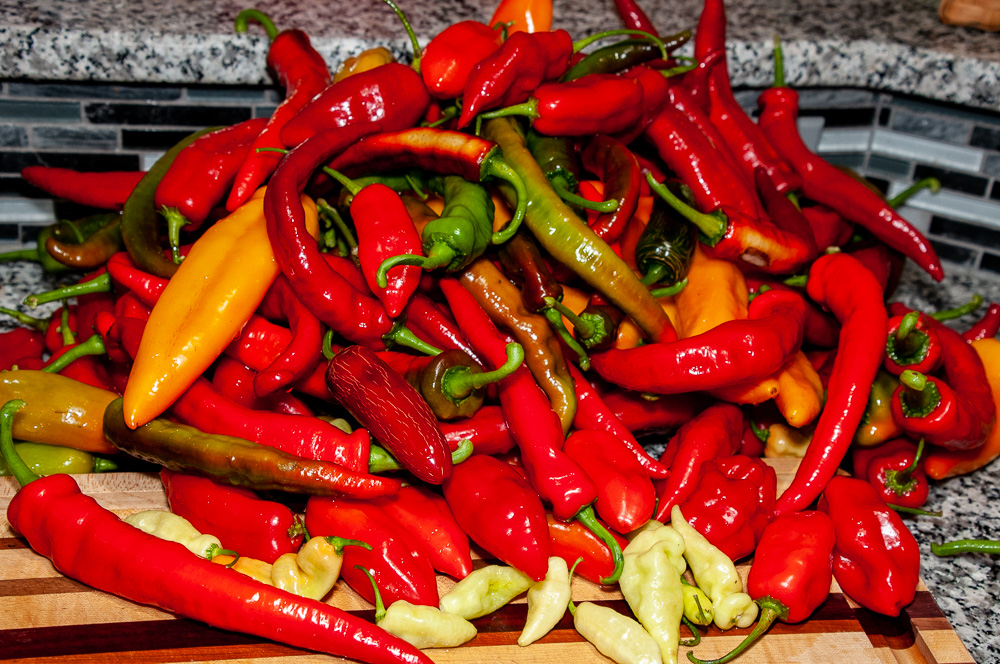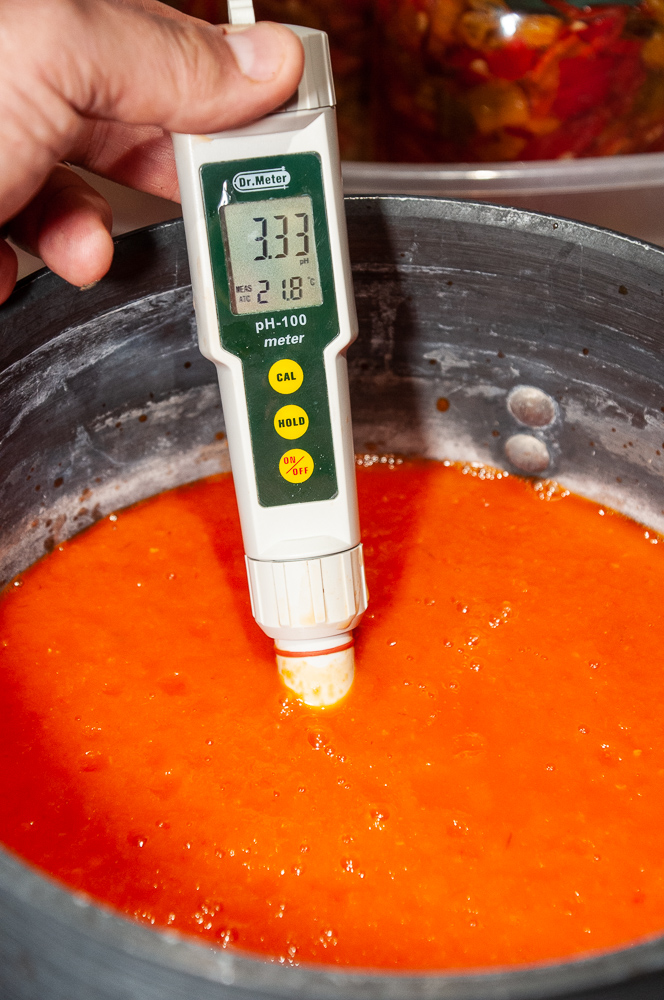We have been making fermented hot sauce for a number of years. This has been what we refer to as “Cold Snap” hot sauce as it is made after the first killing frost where we hope for as many ripe peppers as possible. The color of the sauce varies year to year depending on how early the frost is and how many of the peppers are fully ripe (red or yellow).

Last year we experimented with various Lactobacillus cultures and the Lactobacillus Helveticus won out among the tasters. So we used that exclusively for this year’s batch. You may wonder: “Why use a starter culture when the peppers can ferment naturally?”. This is a valid question as peppers, salt and water have been used for hundreds of years. However the use of an appropriate starter provides the advantages of: repeatability; faster time to fermentation; better blocking of spoilage bacteria, yeasts and molds; and the ability to tweak the flavor profile. With the inoculated batches they are strongly bubbling away the next day, giving a 2-4 day head start over just using the naturally occurring bacteria. With the desirable bacteria growing strongly they are better able to out compete the others. The peppers fermented for 2 weeks and we had 2 of 8 jars with mild kahm yeast growth and no mold in any of them. So all were usable and the flavor is excellent.
They other key to making the hot sauce earlier in the season was that I had chosen some new pepper varieties to grow. Arapaho is a gigantic hybrid cayenne type pepper with 50K Scoville Units. Aji Rico is a South American style moderately hot pepper (5-15K Scoville Units) . Both ripened at the start of September, here in SE Wisconsin (approx 90 days after transplanting). They are way ahead of the others except for the “Gatherer’s Gold” sweet Italian peppers. So these new peppers became the basis for the hot sauce (40% Arapaho, 40% Aji RIco, 15% Gatherer’s Gold . There were a few jalapenos and Habenada thrown in for the last 5%.
This recipe should yield safe stable hot sauce. We make a lot for gifts and our own use.

Preparation and Fermentation:
- The fermenting peppers will be placed in wide mouth quart jars
- Cut and seed the peppers removing the seeds and membranes. Chop into 1/4″ pieces.
- Peel and chop 1/2 bulb of garlic per quart jar
- 1/4 can of limeade concentrate per quart jar
- Place the garlic and limeade in each jar. Pack the jar to the neck with pepper and pound down tightly
- Mix 4% brine (e.g. 1 Liter water with 40 g canning / pickling salt). Sprinkle some of the Wildpitch Lactobacillus Helveticus culture (~1/4 tsp) onto the brine, stir and let it rest for 15 min. Then stir again and pour the brine into each jar up to the neck. It should take 1-2 cups per jar depending on how tightly your peppers are packed.
- Place the glass weight in each jar. You can substitute a water filled plastic bag if you don’t have weights
- Cap with lid and air lock . Place the jars in a warm (70-85F location) in a plastic storage bin, to catch the overflow.
- Tilt, swirl each jar daily to dislodge the CO2 bubbles and ensure the top is wet.You dont want pieces of peppers on the surface drying out as they will get moldy. Remove lids, check for floaters and replace once per week. Scrape off any white film (Kahm Yeast). We fermented this batch for 2 weeks. It could go longer.

Cooking and Bottling:
Skim any yeast from the top of each jar. Place each jar contents in a blender. Pulse initially a few times to release some of the trapped CO2. Then blend on the highest speed for a minute to liquify.

Check the pH. It needs to be <3.8 for shelf stable hot water processing. These batches were at 3.31 and 3.37. If not low enough, either continue fermenting or add lemon juice or vinegar. However I hate vinegary hot sauce.
Place the pepper puree in the stock pot and bring to a boil. Simmer for 15 min. This step is important to release the remaining trapped gasses in the pepper puree and avoid blowing the tops off when hot water processing.
Ladle the hot sauce into the bottles. We use 5 oz “woozy” bottles which are traditional for hot sauce. Each quart of pepper mix will yield 5-6 bottles. Leave about an inch of head space prior to capping.
Hot water process in boiling water bath for 15 minutes.

Remove from the water, let cool for 10 min and then re-tighten all of the caps.
Add the shrink bands and shrink by dunking the bottles in the still hot water or using a heat gun.
Label once cooled.

This years batch has a bit of an orange cast compared to the last bottle from last year. I think that next year I will probably go back to red sweet Italian peppers to keep the rich red color.
Read reliable food safety and recipe information such as stated and federal regulatory guidelines and the various University Extension offices. Don’t rely only on web sites (including this one) for the final say on food safety.
Resources:
Home Canning Salsa https://estill.ca.uky.edu/files/fcs3581_canning_salsa.pdf
Ferment: A guide to the Ancient art of Cultured foods https://amzn.to/3u9xhMJ
Fermentation Weights https://amzn.to/3AEifkO
Stainless one piece fermentation lids and airlocks https://amzn.to/2XV7z2T
Woozy bottles with lids and seals
Lallemand Widlbrew Helveticus Pitch https://www.northernbrewer.com/products/lallemand-wildbrew-lactobacillus-helveticus
Fermented Hot Sauce (Last Year’s batch)
please note: I may get referral payments for the Amazon links
